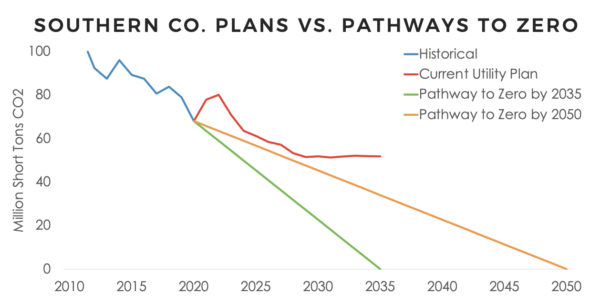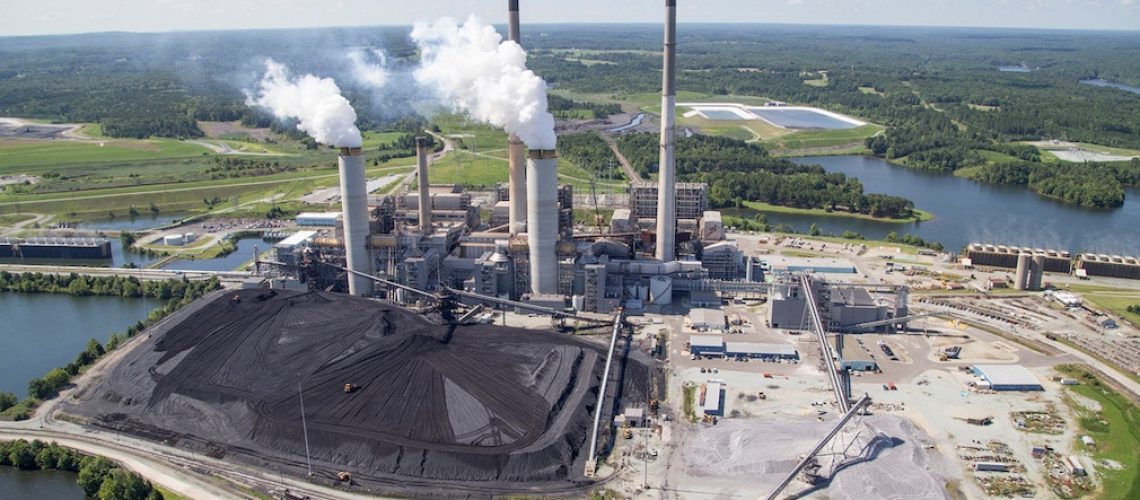Five major Southeastern utilities will not reach zero-carbon generation until 2071 or later, an environmental group projects.
“Every year matters,” says the Southern Alliance for Clean Energy (SACE), in a study projecting when five major utilities in the region will reach zero-carbon generation.
Solar generation across the five utilities will rise to only 9% by 2030, and wind generation will reach just 1%, the study found. Gas generation will continue to increase through 2030, while coal generation will decline from 12% to 6%.
SACE reviewed the most recent ten-year resource plans for the five utilities, which indicated modest clean energy progress through 2030. If each utility’s progress then continued at the same rate, they would meet their announced clean energy goals by 2071 or later, the study found, as shown below. In comparison, SACE said, the scientific consensus is that global emissions must peak by 2025, decline rapidly, and reach net-zero by 2050 to limit global temperature rise to 1.5 degrees Celsius, citing a report by the Intergovernmental Panel on Climate Change (IPCC).
The IPCC report was “really clear” that the first step to achieving the targets it laid out is to stop building new fossil fuel infrastructure, said Maggie Shober, director of utility reform at SACE, in a webinar. The SACE report graphed the projected decarbonization path for each utility, in comparison to pathways to zero by 2030 or 2050, as in the graph at right for Southern Company.
While new fossil gas plants planned by many of the utilities have lower carbon dioxide emissions than coal plants, Shober said, upstream methane emissions from gas production and distribution, which SACE estimated at 1% to 5%, “make the math a lot more difficult to justify those new gas plants.” The cost of solar continues to decline, while the cost of storage is declining rapidly, she added.
Words and deeds
SACE highlighted each of the five utilities’ recent actions with regard to renewables deployment, stating that:
- While NextEra Energy, parent company of Florida Power & Light, announced a company-wide goal to reach carbon-free energy by 2045, an FPL lobbyist wrote the text of a Florida anti-rooftop-solar bill, a bill that was ultimately vetoed by the governor.
- Duke Energy has a corporate goal to reach net-zero by 2050. The utility is required by a North Carolina law to reduce CO2emissions from electricity generation in the state by 70% below 2005 levels by 2030, and reach net-zero by 2050, but only one of the four scenarios in the utility’s proposed “carbon plan” would meet the 70% by 2030 target.
- Southern Company is on track to reduce its carbon emissions 50% from 2005 levels by 2030. The “only significant” expected emissions reduction is from the nuclear Plant Vogtle units under construction.
- Dominion South Carolina’s parent company has a goal to reach net zero CO2 and methane emissions from its power generation by 2050. South Carolina regulators rejected the utility’s first resource plan in 2020, requiring it to model renewables additions prior to 2026.
- The Tennessee Valley Authority, a federally owned utility, “aspires” to an 80% carbon reduction by 2035, while an executive order from President Biden calls on the federal government to pursue 100% clean energy by 2035. TVA’s last resource plan used now-outdated 2018 cost data for renewables, and the utility recently announced plans to replace a coal plant with a gas plant.

Shober said in the webinar that citizens could influence their utility’s pace of decarbonization by working to make utilities’ resource plans better, both through involvement with groups like SACE, and by learning who are the regulators for their utility, finding out where they stand on decarbonization, and getting involved in choosing those regulators, where possible.



